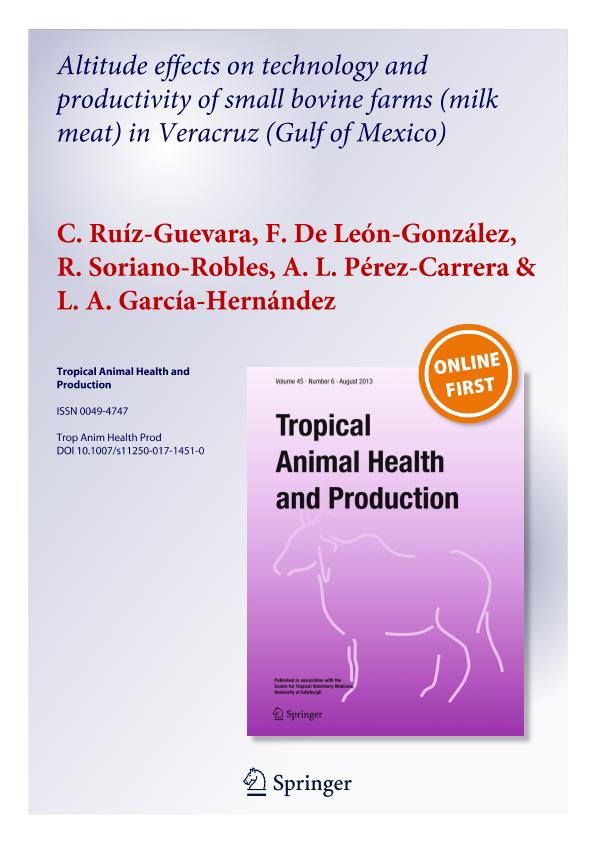Mostrar el registro sencillo del ítem
dc.contributor.author
Ruíz Guevara, C.
dc.contributor.author
De León González, F.
dc.contributor.author
Soriano Robles, R.
dc.contributor.author
Pérez Carrera, Alejo Leopoldo

dc.contributor.author
García Hernández, L. A.
dc.date.available
2018-09-12T14:23:09Z
dc.date.issued
2018-03
dc.identifier.citation
Ruíz Guevara, C.; De León González, F.; Soriano Robles, R.; Pérez Carrera, Alejo Leopoldo; García Hernández, L. A.; Altitude effects on technology and productivity of small bovine farms (milk meat) in Veracruz (Gulf of Mexico); Springer; Tropical Animal Health And Production; 50; 3; 3-2018; 469-476
dc.identifier.issn
0049-4747
dc.identifier.uri
http://hdl.handle.net/11336/59260
dc.description.abstract
The dual-purpose bovine system represents 98.4% of the bovine livestock of Veracruz, the main cattle-producing state of Mexico. This system supplies calves to meat companies, a sector in which Veracruz has been the national leader in the last decade. The objective of the present study was to analyze the effect of the altitudinal zonation of farms on livestock technology and productivity in a microbasin of the Gulf of Mexico where small farms predominate. Structured interviews were applied to producers located in three altitudinal zones (at average altitudes of 50, 140, and 450 m, respectively, for lower, middle, and upper zones). Sample size was 135 farms having similar land surface (within a range of 15–22 ha). The results indicated multiple differences among farms located in the three zones. Farms in the middle and lower zones presented higher productive indicators than those in the upper zone. Differences in herd structure and management resulted in important differences in productivity, income, and profits in milk and calf production. We concluded from this study that altitudinal zonation in Veracruz had a clear effect on the differentiation of small farms, which are representative of dual-purpose cattle. The upper zone performs cattle activity under conditions with greater disadvantages in the analyzed region.
dc.format
application/pdf
dc.language.iso
eng
dc.publisher
Springer

dc.rights
info:eu-repo/semantics/openAccess
dc.rights.uri
https://creativecommons.org/licenses/by-nc-sa/2.5/ar/
dc.subject
Climate Change
dc.subject
Dual-Purpose Cattle Production
dc.subject
Poverty
dc.subject
Rural Development
dc.subject
Small Livestock Farms
dc.subject
Sustainability
dc.subject
Tropical Grasses
dc.subject.classification
Otras Producción Animal y Lechería

dc.subject.classification
Producción Animal y Lechería

dc.subject.classification
CIENCIAS AGRÍCOLAS

dc.title
Altitude effects on technology and productivity of small bovine farms (milk meat) in Veracruz (Gulf of Mexico)
dc.type
info:eu-repo/semantics/article
dc.type
info:ar-repo/semantics/artículo
dc.type
info:eu-repo/semantics/publishedVersion
dc.date.updated
2018-09-11T14:46:15Z
dc.identifier.eissn
1573-7438
dc.journal.volume
50
dc.journal.number
3
dc.journal.pagination
469-476
dc.journal.pais
Países Bajos

dc.journal.ciudad
Dordrecht
dc.description.fil
Fil: Ruíz Guevara, C.. Universidad Autónoma Metropolitana; México
dc.description.fil
Fil: De León González, F.. Universidad Autónoma Metropolitana; México
dc.description.fil
Fil: Soriano Robles, R.. Universidad Autónoma Metropolitana; México
dc.description.fil
Fil: Pérez Carrera, Alejo Leopoldo. Universidad de Buenos Aires. Facultad de Ciencias Veterinarias. Centro de Estudios Transdisciplinarios del Agua; Argentina. Consejo Nacional de Investigaciones Científicas y Técnicas; Argentina
dc.description.fil
Fil: García Hernández, L. A.. Universidad Autónoma Metropolitana; México
dc.journal.title
Tropical Animal Health And Production

dc.relation.alternativeid
info:eu-repo/semantics/altIdentifier/doi/http://dx.doi.org/10.1007/s11250-017-1451-0
dc.relation.alternativeid
info:eu-repo/semantics/altIdentifier/url/https://link.springer.com/article/10.1007%2Fs11250-017-1451-0
Archivos asociados
